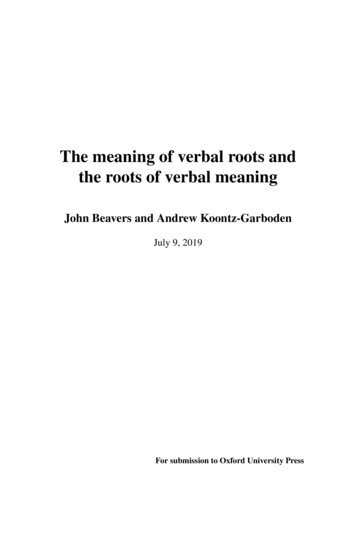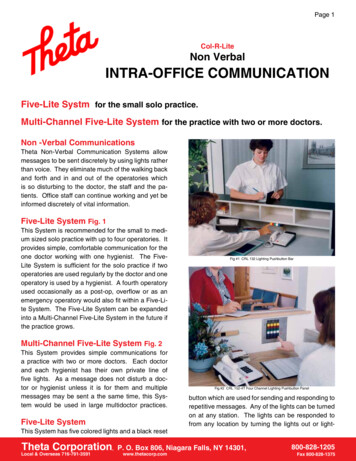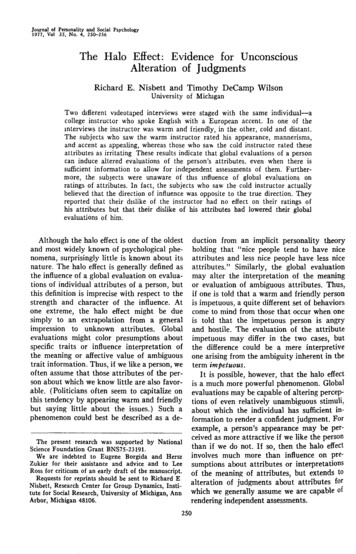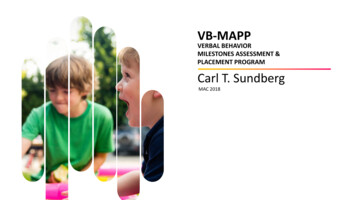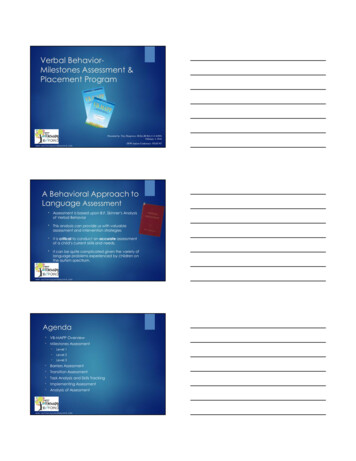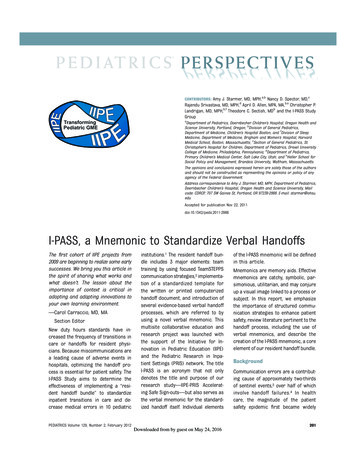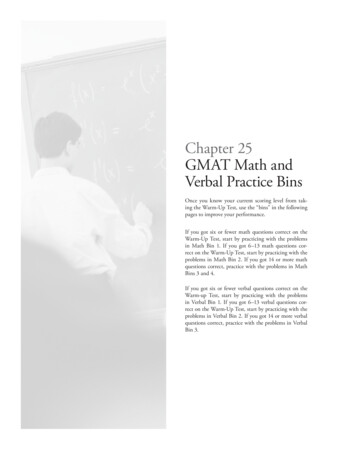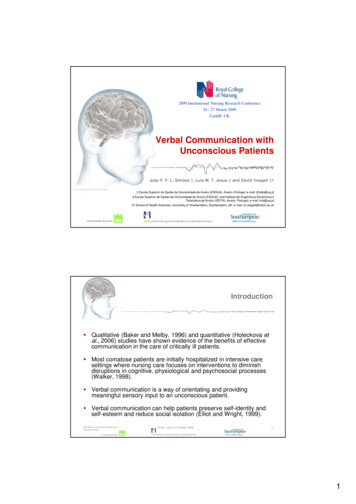
Transcription
2009 International Nursing Research Conference24 - 27 March 2009Cardiff, UKVerbal Communication withUnconscious PatientsJoão F. F. L. Simões †, Luis M. T. Jesus ‡ and David Voegeli ††From Alzheimer's Association (2009).† Escola Superior de Saúde da Universidade de Aveiro (ESSUA), Aveiro, Portugal; e-mail: jflindo@ua.pt‡ Escola Superior de Saúde da Universidade de Aveiro (ESSUA), and Instituto de Engenharia Electrónica eTelemática de Aveiro (IEETA), Aveiro, Portugal; e-mail: lmtj@ua.pt†† School of Health Sciences, University of Southampton, Southampton, UK; e-mail: d.voegeli@soton.ac.ukIntroductionQualitative (Baker and Melby, 1996) and quantitative (Holeckova etal., 2006) studies have shown evidence of the benefits of effectivecommunication in the care of critically ill patients.Most comatose patients are initially hospitalized in intensive caresettings where nursing care focuses on interventions to diminishdisruptions in cognitive, physiological and psychosocial processes(Walker, 1998).Verbal communication is a way of orientating and providingmeaningful sensory input to an unconscious patient.Verbal communication can help patients preserve self-identity andself-esteem and reduce social isolation (Elliot and Wright, 1999).27th March (Concurrent Session 9.2.1Communication)Simões, Jesus and Voegeli (2009)21
Purpose of our studyCharacterise and standardise verbal communication that criticalcare nurses and families use with unconscious patients.Building a stimulus message to be used with unconsciouspatients, to examine if the effects of familiar and unknown voiceswould be significantly different (blood pressure, pulse, oxygensaturation level, temperature, glycaemia level and ECG values weremonitored as evidence of auditory perception).27th March (Concurrent Session 9.2.1Communication)3Simões, Jesus and Voegeli (2009)MethodThe verbal communication of critical care nurses and patients’families, as reported in the literature, was thoroughly analysed,including references related to verbal communication by thepatients’ family and intensive care nurses.The results of the content analysis were used to build the stimulusmessage, which was further refined with the cooperation of a groupof experts (speech and Language therapists, and psychologists).The stimulus message has an increasing degree of stimulationthroughout: pleasant contents orders27th March (Concurrent Session 9.2.1Communication)Simões, Jesus and Voegeli (2009)42
References’ thematic areasTHEMATICAREASREFERENCESAdvantages ofverbalcommunication withthe unconsciouspatientResponses ofunconsciouspatients to verbalcommunicationPurpose of verbalcommunication bynursesPurpose ofverbalcommunicationby patients’familyBaker and Melby (1996)Danoy, Curallucci and Dor(1992)Holeckova et al (2006)Machado (1995)Puma and Schiedermayer(1990)Verity (1996)Danoy, Curallucci andDor (1992)Ferreira (2000)Holeckova et al (2006)Johnson, Omery andNikas (1989)Machado (1995)Perrin et al (2006)Puma and Schiedermayer(1990)Walker, Eakes andSiebelink (1998)Baker and Melby (1996)Doman et al (1993)Danoy, Curallucci andDor (1992)Elliot and Wright (1999)Ferreira (2000)Holeckova et al (2006)Hoyt (1996)Machado (1995)Puma andSchiedermayer (1990)Verity (1996)Danoy, Curallucci andDor (1992)Hoyt (1996)Machado (1995)Puggina (2006)Walker, Eakes andSiebelink (1998)68105TOTALNUMBER27th March (Concurrent Session 9.2.1Communication)5Simões, Jesus and Voegeli (2009)Advantages of verbal communicationwith the unconscious patientFOR INTENSIVECARE NURSESTherapeuticrelationship9,5%To apply the scientificmethodology9,5%Feedback27th March (Concurrent Session 9.2.1Communication)Simões, Jesus and Voegeli (2009)33,3%14,3%63
Advantages of verbal communicationwith the unconscious patientTo promote attentionTo promote orientation9,5%4,8%Therapeutic valueFOR UNCONSCIOUSPATIENT28,5%To reduce the risk ofpsychological disorders4,8%To reduce anguish4,8%9,5%To reduce anxietyTo relax27th March (Concurrent Session 9.2.1Communication)66,7%4,8%7Simões, Jesus and Voegeli (2009)Responses of unconscious patientsto verbal communicationWITHOUTRESPONSEUnaltered physiologicalparameters2,3%Brainstem2,3%Coma patient4,8%14,0%Cerebral sectionsNEUROLOGICALALTERATIONS27th March (Concurrent Session 9.2.1Communication)Level ofconsciousness2,3%Glasgow ComaScale score2,3%Simões, Jesus and Voegeli (2009)9,3%18,6%84
Responses of unconscious patientsto verbal rspiration2,3%Agitation2,3%Spasticity2,3%To ntracranial Pressure (ICP)11,6%Arterial pressure11,6%Corporal temperature4,8%Breathing11,6%Pulse27th March (Concurrent Session 9.2.1Communication)16,3%9Simões, Jesus and Voegeli (2009)Purpose of verbal communicationby nursesTO INFORMClinical equipment2,9%Member of a familycontact2,9%Clinical statusTO PRAISETO ousness1,0%Movement2,9%Response to auditorystimulusDecreasing level ofanxiety and stressTo collaborate27th March (Concurrent Session 9.2.1Communication)Simões, Jesus and Voegeli (2009)9,8%7,8%20,6%4,9%2,0%105
Purpose of verbal communicationby nursesCerebral reflexesTO EVALUATE4,9%Daily habits3,9%Time and space14,7%44,1%Motive to beunconsciousTO ORIENTTO IDENTIFY3,9%Nurse’s action21,7%Medicine1,0%Member ofthe family1,0%18,6%Nurse7,8%Coma patient27th March (Concurrent Session 9.2.1Communication)8,8%11Simões, Jesus and Voegeli (2009)Purpose of verbal communicationby patients’ familyTo forget theaccident0,2%To collaborateTO STIMULATEOrientation0,6%0,4%Religion belief/faith2,8%To encourage andto tranquilizeResponse22,9%5,6%0,6%Recovery12,8%Group contactTO ORIENTDaily habitsTime and spaceAdmission motive27th March (Concurrent Session 9.2.1Communication)3,7%Relative contactSimões, Jesus and Voegeli (2009)4,8%18,2%0,7%4,8%4,1%126
Purpose of verbal communicationby patients’ familyRepentance0,4%Impotency feelingTO INFORM0,6%Clinical status2,0%Family support1,5%Religion belief/faithClinicalequipmentBarrier tocommunication10,8%0,2%Clinical care43,4%0,4%1,9%Missing5,8%Relation with the coma patientTO IDENTIFYDaily living15,6%4,2%RelativeComa Patient27th March (Concurrent Session 9.2.1Communication)8,8%15,5%6,7%13Simões, Jesus and Voegeli (2009)Composition of the stimulus messagePresentation andorientationInformationIdentification of theperson comaCurrent factsStimulate and evaluateverbal replyIdentification of theprofessional(name, profession)Informationconcerning the familyStimulate and evaluateopening of eyesInformation concerningprior (to coma) daily lifeactivitiesStimulate and evaluatemotor replyTime orientation (time,month, day of the weekand weather)Space orientation(current localization,bed and procedures)Functional assessmentand stimulationTo rememberimportant eventsPresentation of the study27th March (Concurrent Session 9.2.1Communication)Simões, Jesus and Voegeli (2009)147
Stimulus messagePresentationand orientationBom dia Senhor(a) A (no caso da pessoa significativa devedizer o nome pelo qual era habitual chamar a pessoa emcoma). Como se está a sentir hoje?O meu nome é B e sou um dos enfermeiros que está acuidar de si (no caso da pessoa significativa deve identificarse dizendo o seu nome e grau de parentesco ouvinculação).Hoje é dia x de (mês), é (dia da semana) e são y horas damanhã. Está uma manhã cinzenta e fria característica deInverno (se for outra época do ano deve-se adaptar).Agora está numa enfermaria de cuidados intensivos paratermos oportunidade de cuidar melhor de si e vigiarmoscontinuamente se está tudo bem. Está numa sala diferentecom muitos aparelhos e muitas pessoas a circular (no casoda pessoa significativa deve referir que são os enfermeiros,médicos e outros profissionais que estão a cuidar dele(a)).27th March (Concurrent Session 9.2.1Communication)15Simões, Jesus and Voegeli (2009)Stimulus messageNão sei se já tentou comunicar connosco, ou até se lheprestaram atenção quando o tentou fazer anteriormente,mas tente agora. Nós não sabemos se o senhor nosconsegue ouvir, mas pensamos que sim, por isso vamosestar atentosInformationTal como já lhe disse, estive a conversar com a sua famíliae queria dizer-lhe que está tudo bem com ela. Os seusfamiliares disseram-me que gostam muito de si e queesperam que recupere rapidamente. O Senhor gosta dasua família?Quando conversei com a sua família também me disseramque o senhor é professor de Português. Disseram-me quegosta muito daquilo que faz. Deve ser interessante poderensinar outras pessoas. Sente saudades dos seus alunos?(deve-se adequar esta parte à profissão da pessoa emcoma).27th March (Concurrent Session 9.2.1Communication)Simões, Jesus and Voegeli (2009)168
Stimulus messageSenhor(a) A consegue falar? [Pausa] Vamos, tente falar.[Pausa] Agora tente mexer a língua e os lábios. Devagar,tente mexer a sua língua e os seus lábios. [Pausa]Senhor(a) A continue, vamos, continue a tentar, mexa a sualíngua e os seus lábios. [Pausa]Senhor(a) A tente abrir os olhos. [Pausa] Conseguiu ouvirme? [Pausa] Senhor(a) A tente abrir os seus olhos. [Pausa]Vamos, tente abrir os seus olhos. [Pausa] Senhor(a) A, euestou aqui para o ajudar, vamos, abra os seus olhos.[Pausa]Functionalassessment andstimulation27th March (Concurrent Session 9.2.1Communication)Senhor(a) A, agora vai tentar fazer outros movimentos,está bem? [Pausa] Vai começar por tentar levantar o seubraço direito. [Pausa] Consegue levantar o seu braçodireito? [Pausa] Vamos Senhor(a) A, levante o seu braçodireito. [Pausa]17Simões, Jesus and Voegeli (2009)ConclusionsThe standard speech stimulus developed will facilitate thecommunication with the unconscious patients as assessed by theproposed physiological signals.The findings of this study highlight the need for formal supportsystems and continued education for nurses about the benefits ofverbal communication.27th March (Concurrent Session 9.2.1Communication)Simões, Jesus and Voegeli (2009)189
Future workMonitoring the ECG signal, blood pressure, pulse frequency, oxygensaturation level, glycaemia level and temperature, before, duringand after the auditory stimulation of the patient in coma with astrange voice and a familiar voice.The most significant person, whose voice we recorded, wasselected using a sociometry test.The integrity of the auditory system will be evaluated in a preliminaryphase based on auditory evoked potentials.Selection of coma patients will be based on the results of a thoroughassessment using the Portuguese version of the CRS-R.27th March (Concurrent Session 9.2.1Communication)19Simões, Jesus and Voegeli (2009)Collecting data withDatex-Ohmeda S/5 CollectOnline waveforms27th March (Concurrent Session 9.2.1Communication)1.Waveforms available for selection2.A maximum of 4 waveform boxes3.The waveform selected to be displayedin the first waveform box. The unitused is displayed under the selectionbox.4.Use the graph palette to scroll thedisplay area of the graph and to zoomin and out of sections of the graph.5.Waveform end time6.Red waveform cursor.7.Scroll bar and scroll box. By movingthe scroll box you can move to thedesired part of the waveform.8.Waveform start timeSimões, Jesus and Voegeli (2009)2010
Collecting data withDatex-Ohmeda S/5 CollectOnline trends27th March (Concurrent Session 9.2.1Communication)Simões, Jesus and Voegeli (2009)1.Trends available for selection2.A maximum of 4 trend boxes3.The trend selected to bedisplayed in the first trend box.The latest numerical parametervalue and the unit are alsodisplayed.4.Use the graph palette to scrollthe display area of the graphand to zoom in and out ofsections of the graph.5.Trend times2111
settings where nursing care focuses on interventions to diminish disruptions in cognitive, physiological and psychosocial processes (Walker, 1998). Verbal communication is a way of orientating and providing meaningful sensory input to an unconscious patient. Verbal communication can help patients preserve self-identity and self-esteem and reduce social isolation (Elliot and Wright, 1999 .
